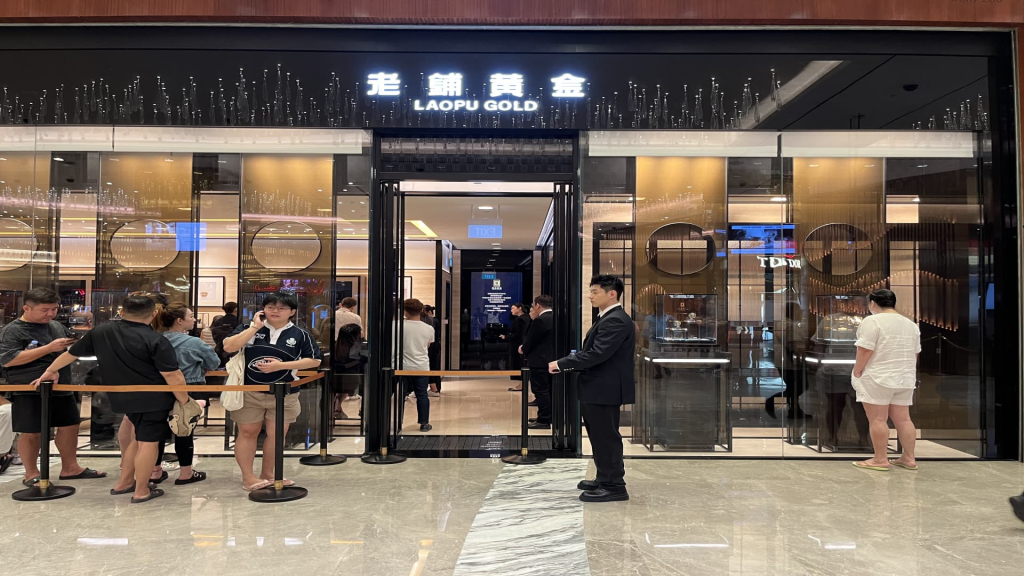Showcasing an aesthetic reminiscent of high-end brands such as Patek Philippe, Laopu’s display windows featured intricately designed pieces, including a golden deer and a lotus sutra urn, positioned artistically against sleek black backgrounds. The company’s product line is rooted in traditional Chinese gold crafting techniques that pay homage to ancient royal jewelry. Jessie Lim, a 52-year-old resident of Singapore, shared her experience of entering the store with modest expectations, only to leave with a $4,000 purchase for herself and her daughter, including a bracelet and a butterfly necklace. “The designs are very exquisite. Even the wings of the butterfly are double-layered,” she remarked, noting the inclusion of diamonds in the jewelry.
The brand’s growing popularity was underscored when San Antonio Spurs player Victor “Wemby” Wembanyama was spotted wearing one of Laopu’s signature “hulu” gourd-shaped pendants during his visit to Beijing last month. This endorsement adds to Laopu’s profile as Wembanyama, a prominent figure in the basketball world, recently became a brand ambassador for LVMH. Laopu’s gourd-shaped pendant, priced at 12,520 yuan ($1,747), stands out on China’s e-commerce platform Tmall, where it has become the brand’s top-selling item, alongside another variant costing 29,250 yuan.
Impressive sales figures have caught the attention of investors, as Laopu reported a staggering 166% increase in sales to 9.8 billion yuan ($1.37 billion) for 2024, as stated in its annual report. The company’s market performance has been notable, with its shares skyrocketing over 2,000% since debuting at HK$40.50 in June 2024.
While the surge in gold prices has benefited Laopu, its rise is particularly striking against the backdrop of declining sales for traditional European luxury brands, which have struggled with soft domestic consumption in China. In May, Richemont, the parent company of Cartier, cautioned investors about the impact of Laopu’s ascent, suggesting that it places pressure on European firms to innovate and enhance the desirability of their brands.
To cater to the Singapore market, Laopu unveiled an exclusive gold cross inlaid with diamonds, boosting its collection that includes the sought-after hulu necklace, infused with Chinese cultural symbolism and folklore. Even after several days post-launch, customers like Xew Ling, a 60-year-old local business owner, encountered an hour-long wait during the week, prompting her to return the following day for a shorter queue of just 30 minutes. Some local workers have even utilized their lunch breaks to beat the lines; Juliana Go, a 58-year-old Singaporean, noted her office’s collective purchase, underscoring the brand’s appeal.
To maintain its luxury stature, Laopu adopts a strategy of infrequent discounts, typically increasing prices at least twice annually regardless of gold price fluctuations, as highlighted by Nomura analysts. The company is also planning to expand with a new store in Japan next year.
Looking ahead, questions abound regarding Laopu’s ability to solidify its position within the global luxury sector as initial excitement wanes. Li Jie, a professor and director at the Luxury Brand Research Center of Shanghai Jiao Tong University, remarked on the brand’s recent growth, attributing it to a robust 16-year foundation of effort. He emphasized that Laopu successfully addresses the diverse needs of middle-class Chinese consumers. In contrast, he noted that many Chinese companies overly focus on either functional or emotional brand value.
As Laopu pursues a slow and steady approach for global branding, exclusivity has played a critical role in its success. Unlike Chow Tai Fook, a venerable Hong Kong jeweler with over 6,500 stores and a 29.5% gross profit margin, Laopu’s selective operational model yields a significantly higher profit margin of 41.2% with fewer than 50 locations.
The company’s growth trajectory owes much to its management overhaul, which saw founder Xu Gaoming take the helm for product innovation in late 2016. Now leading a dedicated team of 20, Xu was appointed chairman in November 2023.
Laopu’s inaugural international store aligns with Singapore’s large ethnic Chinese demographic and its visa-free policy, which has attracted numerous Chinese tourists. Additionally, Oliver Wyman consultant Dave Xie noted that other brands like Florasis have strategically adopted heritage-rich designs to appeal to a broader audience.
As Chinese brands increasingly venture onto the global stage, Laopu Gold’s narrative reflects an opportune moment for local firms exploring international markets, especially in the context of geopolitical shifts and changing consumer preferences. Within China, local brands have captured significant market share, with seven out of the top 15 luxury handbag rankings on Tmall occupied by homegrown companies, as reported by Ashley Dudarenok, founder of ChoZan.
Dudarenok suggests that if Laopu can harmonize its authentic storytelling with a universal appeal, it may well emulate the path of leading European luxury brands. The strategic choice of Marina Bay Sands, with its impressive portfolio of over 170 luxury brands, serves as a strong platform for Laopu’s ambitions. Hazel Chan, senior vice president of retail at Marina Bay Sands, welcomed Laopu, stating that the introduction of this new brand would enhance their luxury offerings.
While the landscape for Chinese luxury brands is evolving, market experts caution that for every success, there may be failures. However, there is a consensus that Chinese enterprises are now challenging their Western counterparts and adapting to rapidly changing consumer demands.


























